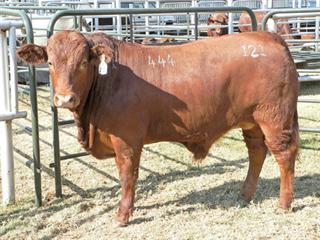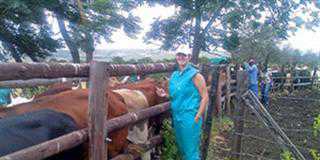
“Lawrence Moorcroft’s brands are so clear that his cattle can be easily identified from a low-flying aircraft,” comments Captain Rassie Erasmus, commanding officer of the SA Police Stock Theft Unit. His remark sums up a major principle of livestock production and trade. Livestock production and marketing is based on two fundamental concepts: identifying an animal and its parts and products through time and space from the farm to the consumer, and linking it to its rightful owner at any time.
This requires certain steps and processes:
- Individual animals must be marked so that they can be identified in a system used throughout the geographical production and marketing area.
- An animal’s identity must be linked to its owner.
- Change of ownership (such as when it is sold, lost or stolen) and the animal’s status (including veterinary records, treatment, injury, death and marketing) should be recorded. Additional information, such as breed, registration details, pedigree, reproductive status and records, performance evaluation records, genomic information and progeny identity, is logged for stud animals.
Ownership and status
Reliable livestock identification is important when owners may be liable for damage, injury or death to a third party caused by their animal/s. Livestock identification and traceability is based on two interlinked concepts:
Identification
Marking the animal and linking it to an owner.
Traceability
Tracking a marked animal from birth to the eventual end-consumer of the various animal products from that animal. As applied to the consumer, traceability may only extend back to the specific farm, area or production system of origin and not necessarily to the individual animal.
This article looks at broad principles of traceability and its economic importance with reference to cross-border trade. Subsequent articles will focus on certain practical aspects, including ways of marking and identifying livestock and the characteristics, advantages, disadvantages, legal implications, limitations and practical applications of each, and the legal framework and economic advantages to the farmer.
Economic implications in terms of establishing a national data base, combating stock theft, managing local and international trade, genetic management and breed improvement will also be covered.
What is traceability?
The ISO 8402 standard defines traceability as “the capacity for establishing a product’s origin, process history, use and provenance by reference to written records”. A system with traceability has three key characteristics:
- Breadth – The amount of information recorded, such as vaccinations and feeding regime.
- Depth – How far back or forward the system tracks.
- Precision – The degree of confidence with which the tracing system can pinpoint the movement of an animal product, with reference to an acceptable error rate or the consequences of a tracking mistake.
Tracing livestock has become more complicated as animals may be traded many times before being ready for slaughter. In addition, many are slaughtered hundreds of kilometres from their farm of birth or rearing. Trade between European countries, in live animals is common, increasing the risk of spreading epidemic diseases. Council of the European Union Resolution 94/C 16/01 recommends veterinary research into organised surveillance of farm systems, to assure health standards. This probably points the way to animal trading in the SADC region.
A unique, secure and uniform identification system, linked to a database to support livestock identification, health records and traceability to origin, is important for traceability. Data must be securely transferred between different national databases and must be immediately accessible.
Protection against loss
Livestock identification must be secure and fraud-proof for efficient control or eradication of diseases and to protect farmers from theft or loss. Identification must support livestock transactions; prevent fraud in subsidy programmes; assure food safety and high quality brand name retail meat products.
A good system should enable efficient trace-back in case of food-borne diseases; promote consumer confidence; add value as a benefit of supply chain management; preserve genetic value traits; confirm the origin of production; and identify and include unique inputs and processing methods such as free range production.
Health and movement
The need to trace the origin of animals arises as soon as infectious disease control is implemented in a population. An identification and registration system for animals is crucial to planning and implementing disease prevention and control. As an example, cattle identification has played a vital role in livestock health in Canada. From the 1950s to the 1980s, 95% of the Canadian cow herd was individually identified under the Health of Animals programme, in a campaign to eradicate brucellosis. In 1985, the country was declared brucellosis-free.
International trade has increased concerns about the movement of livestock diseases across borders. One of the main missions of the World Organisation for Animal Health (OIE) is to guarantee the health safety of world trade by developing rules for international trade in animals and animal products. OIE recognises standards for animal health and animal diseases transmissible to humans in international sanitary rules.
Consumer protection
A livestock identification system affects consumer protection in several ways.
- It enhances the ability to respond to a biosecurity threat and to control and eradicate a foreign livestock disease outbreak.
- It helps industry meet foreign and domestic consumer demands for source-verified products.
- It reduces intentional and unintentional biosecurity threats to the domestic food supply.
Food safety
A link between livestock producers and the slaughter/processing industries through a reliable system would enhance food safety. A trace-back and recall system for livestock products destined as human food from final point of sale to producer would contribute to the prevention of disease in humans and would enable processors to recognise potential hazards in the food chain.
In food safety policies based on Hazard Analysis Critical Control Point (HACCP), producers are asked to guarantee livestock product quality by documenting all steps of the food chain. These include clear records on feed safety and livestock health to guarantee final product wholesomeness and make sure that appropriate corrective action is taken if needed.
A hazard analysis of the processing steps from farm to abattoir, and subsequently into processing and retail, enables public health officials to protect the public from pathogens, diseases or residues. A reliable livestock identification system enables public health officials to trace forward to prevent consumption of animal products exposed to latent diseases or pathogens. The information and data requirements may extend from the abattoir to the consumer, or back to the farm of origin.
A herd or flock’s health status can be determined before the animals are transportated to slaughter, enabling high-risk animals to be separated from low-risk animals for inspection and slaughter. In combination with pathogen baseline data
and microbiological profiles of products, the data could help identify farm management and livestock marketing practices that affect food safety. A trace-back capability is important to food safety as it minimises the danger of meat-borne pathogens to the restaurant industry. Trace-back to the birth of the animal would reduce the threat of meat-borne pathogens in the meat chain.
Consumer groups would like to establish a better database on trace-back to assure that the responsibility for trace-back and recall in relation to relative food poisoning organisms is under government authority.
Cost distribution
Livestock identification that allows trace-back throughout the fork-to-farm continuum would attribute the cost of food-borne diseases and the benefits of preventive measures to the appropriate link in the meat chain. A farmer who can provide documentation that his animals are more valuable due to being up-to-date with vaccination, veterinary care and animal welfare provisions, is more able to negotiate a higher price for his livestock.
A national (and international) livestock identification system will assist producers to maximise the profit of their enterprises and assure sustainability by identifying animals that consistently grow as fast as possible, eat as little as possible, require minimum veterinary attention and still produce the best-grading carcasses.
Source: Review of biometric and electronic systems of livestock identification Ursula Gonzales Barron and Professor Shane Ward.
Email Professor Shane Ward on [email protected]












